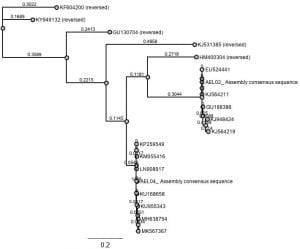Allyson Luber
November 19th, 2019
This lab session was combined with lecture for time efficiency. Order of class:
- PCR 1 TEST
- LECTURE
- GEL
- PCR 2 (final)
I. Test PCR: We tested for successful library construction of our Mimulus guttatus samples (restriction digest + ligation of barcodes) using a test PCR. PCR I: TESTS THE SUCCESS OF LIBRARY CONSTRUCTION. This PCR was performed with inexpensive non-high-fidelity Taq.
- Create Master Mix 1
- Ran PCR using PCR1 on BIORAD #1/2: 94 degrees celsius for 2 min, then 20 cycles of (94, 60, 68 degrees celsius for 30 seconds for all). 4-10 degrees celsius infinite hold
- After taken out of the PCR machine we ran the products of PCR 1 for each sample on a 1.5% agarose gel (o.75 g agarose in 50 mL TX TAE) with a 100 bp ladder at 130V for 40 minutes
Test PCR tubes (Samples 25-32)
Master Mix 1: Recipe for one PCR reaction of 16.0 μL. 10 rxn’s
- NEB One-Taq 2x Master Mix (8.0 μL/1 rxn): 80 μL
- Forward Primer (Primer 026, 10mM) (0.40 μL/1 rxn): 4.0 μL
- Reverse Primer (10mM) (0.40 μL/1 rxn): 4.0 μL
- Pure H2O (6.2 μL/1 rxn): 62 μL
- Master Mix total: (15.00 μL/1 rxn) 150 μL
- Library DNA Template (1.00 μL) –> total reaction volume 16.0 μL
II. Final PCR (PCR 2): This PCR run added the special “second barcode” sequences and the Illumina primers to our libraries of Mimulus gutattus, allowing us to identify which specific individuals a given sequence came from (Ligation barcode + PCR2 barcode). Each table used a different PCR2 primer. Our table: PCR2_7. PCR2: to generate final Illumina sequencing library
To add Illumina flowcell annealing sequences, multiplexing indices, and sequencing primer annealing regions to all fragments and to increase concentrations of sequencing, we performed a PCR amplification with a Phusion Polymerase kit
- For each library, we set up 4-8 PCR reactions (to combine and mitigate PCR bias) in 50 μL total volume
- For each PCR reaction, combine:
- ~20 ng (~3 μL depending on concentration) of size-selected sample
- PCR primers 1 and 2 at concentration 10 uM each
- The recommended amount of 5X-HF buffer, 10 mM dNTPs, water, and Phusion DNAP
- Vortex, then spin down in microcentrifuge
- Run PCR2 on BIORAD #2 (Usually 10-20 cycles is sufficient). Increasing cycle number beyond this can introduce substantial mis-incorporation and exacerbate size and composition bias in final libraries
- Ran 2 μL of the products of PCR2 on a 1% agarose gel with a 100 bp ladder
Final PCR on samples 25-32 using PCR2_7
Master Mix 2 Recipe: One PCR rxn = 25.0 μL. 10 rxn’s made = ~220 μL
- Phusion DNA Polymerase (o.31 μL/ 1 rxn): 3.1 μL
- 5X Phusion HF buffer (6.25 μL/1 rxn): 63 μL
- Forward primer (1.56 μL/ 1 rxn): 15.6 μL
- Reverse primer (1.56 μL/ 1 rxn): 15.6 μL
- DNTPs (0.63 μL/ 1 rxn): 6.3
- DMSO (0.94 μL/ 1rxn) : 9.4 μL
- Pure H2O (10.75 μL/ 1 rxn): 108 μL
- Master Mix Total (22.0 μL/1 rxn): ~220 μL
- Library DNA Template: 3.00 μL/1 rxn + MM Total = 25.0 μL/1 rxn
